Award-Winning Plants of 2022
March 22nd, 2022
Which plants will work best in your yard?

Coralbells ‘Caramel’
One strategy is considering plants that have won awards from various plant-trial and plant-selection programs.
Each year, organizations of growers, horticulturists, researchers, and other plant experts bestow awards on top plant performers – some new, some old but just under-used.
Here’s a look at plants that have won honors for 2022:
A panel of experts assembled by the Pennsylvania Horticultural Society (best known for running the Philadelphia Flower Show) each year picks a half-dozen trees, shrubs, and perennials worthy of greater use in Pennsylvania landscapes.
For 2022, two perennials, two shrubs, and two trees made the Gold Medal grade.
Coralbells ‘Caramel’
‘Caramel’ is a buttery-gold-leafed version of our native alum root (Heuchera villosa) that grows about 14 inches tall and 30 inches wide, ideally in a site that’s out of afternoon sun. It’s a perennial grown mainly for its foliage, although it does produce some wiry white flowers in early summer.
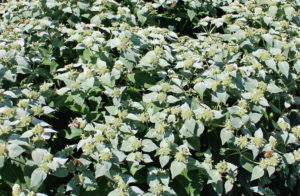
Clustered mountain mint
Clustered mountain mint (Pycnanthemum muticum)
Gardeners trying to attract pollinators might want to start with this mint-family perennial that was the top pollinator-attracting plant in Penn State University trials. Clustered mountain mint grows about three feet tall, produces pinkish-white flowers most of the summer, and has a minty fragrance. Best in full sun.
Abelia ‘Little Richard’
‘Little Richard’ is a tried-and-true, deer-resistant, compact, rounded shrub that produces tubular white flowers for months, starting in late spring. Leaves are semi-evergreen. Plants grow three to four feet tall and wide in sun or part shade.
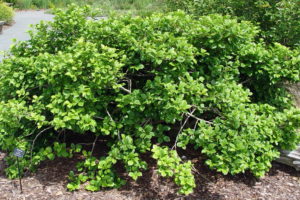
American holly ‘Maryland Dwarf’
Holly ‘Maryland Dwarf’
This evergreen is a native holly with spiny, glossy leaves, but it doesn’t grow anything like the tall-tree form that’s most familiar. ‘Maryland Dwarf’ is actually a low, spreading, berry-producing female holly that grows only about three feet tall but with a spread of 10 feet or more. It does best in moist soil and full sun to part shade.
Maple Autumn Blaze
This fast-growing shade tree is a cross between two native maples (silver and red maples), and like most maples, is most regarded for its brilliant red-orange fall foliage. Autumn Blaze is a reliable and largely trouble-free variety that can grow about 60 feet tall and 40 feet wide. Best in full sun.

Kousa dogwood Scarlet Fire
Credit: Rutgers University
Kousa dogwood Scarlet Fire
Decades in the works at Rutgers University, this new variety of Kousa (Chinese) dogwood tree is distinctive for its rich pink late-spring flowers. It also has red fall fruits, deep-red fall foliage, decorative flaking bark, and excellent disease resistance. Grows about 25 feet tall and 20 feet wide in sun or part shade.
(Disclosure: The author is a member of the Gold Medal panel.)
This program, run by the staff and Horticulture Committee at Jenkins Arboretum and Gardens in Devon, Pa., focuses on singling out some of our region’s best native plants for home landscapes.
Three plants won 2022 Green Ribbon awards:

Woodvamp
Credit: Dawes Arboretum
Woodvamp (Decumaria barbara)
Also known as climbing hydrangea, woodvamp is a fast-growing, deciduous, semi-evergreen, native vine that has glossy dark-green leaves and small, white, pollinator-attracting, mildly fragrant flowers that appear from late spring into summer. The woody branches climb by sucking onto surfaces.
Plants can grow 30 feet or more and do best in partly to mostly shaded spots.
Sweet azalea (Rhododendron arborescens)
Sweet azalea is a native deciduous shrub that can grow up to 10 feet tall and wide. The white or pinkish-white flowers are fragrant and appear in late spring, and the leaves turn crimson-orange in fall before dropping.
Plants grow best in acidic, well drained soil in morning sun and afternoon sun (or dappled all-day light).
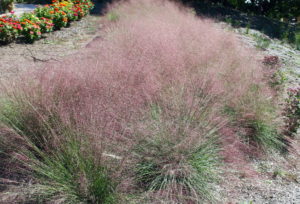
Muhly grass
Pink muhly grass (Muhlenbergia capillaris)
This native ornamental grass is distinctive for its clusters of dainty pink, early-fall seed heads that make the three-foot clumps look like a pink cloud.
The narrow green blades turn copper in fall. Pink muhly grass grows best in full sun but also does reasonably well in part shade.
Members of the Perennial Plant Association vote to honor one perennial plant each year that’s superior in terms of performance, low care, pest resistance, and multiple-season interest. The 2022 winner is…
Little bluestem
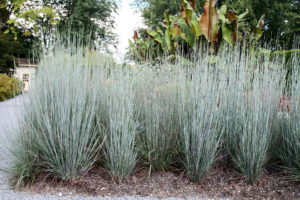
Little bluestem ‘Standing Ovation’
This native clump-forming grass was singled out for its foliage color, which can include gray-green, blue, pink, purple, copper, mahogany, red, and orange as the seasons change.
Plants send up wispy silver-white seed heads in fall.
PPA also notes that little bluestem pairs well with numerous perennial flowers and is attractive to assorted butterflies, moths, and other pollinators.
Garden centers carry several good, compact varieties of little bluestems – most of which grow three to four feet tall and prefer full sun.
Ones that do well in our region include ‘Jazz,’ ‘Standing Ovation,’ ‘The Blues,’ ‘Blue Heaven,’ and ‘Prairie Blues.’
Garden Club of America Plant of the Year
This award is bestowed by the national organization of garden clubs, which appoints a plant-expert panel to name one outstanding U.S.-native plant worthy of the Montine McDaniel Freeman Medal. The 2022 medal-winner:
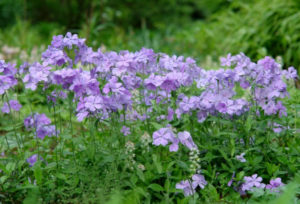
Woodland phlox ‘Blue Moon’
Credit: Garden Club of America/William Cullina
Woodland phlox ‘Blue Moon’
This variety of woodland phlox is a foot-tall native creeper, discovered by Morris Arboretum Executive Director William Cullina, that stands out for its long-lasting, April-through-May lilac-blue flowers that also are larger than other creeping phlox flowers.
‘Blue Moon’ is mildew resistant, a good early-season pollen source for bees and swallowtail butterflies, and a good nectar source for hummingbirds. It’s ideal as a groundcover in shady to partly shaded spots.
Independent researchers each year evaluate hundreds of new flowers and vegetables in dozens of trial gardens throughout the United States. The highest scorers get All-America Selections awards in a program that dates to 1932.
Five new vegetables and three new flowers were good enough to win 2022 national AAS honors.
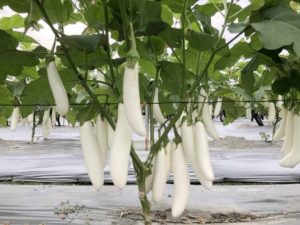
Eggplant ‘Icicle’
Credit: All-America Selections
‘Icicle’ has four improvements going for it: 1.) fewer spines than most eggplants, meaning less painful harvesting; 2.) fewer seeds; 3.) good resistance to bugs, and 4.) elongated white fruits that don’t yellow like most other white-fruited eggplants. Plants grow about four feet tall, ideally in full sun.
‘Buffy’ is a prolific producer of thick-walled, hot to medium-hot, inch-and-a-half long red fruits, capable of churning out 250 to 280 fruits per plant in a single season. Full sun.
This compact, four-inch-tall, disease-resistant oakleaf lettuce has medium-green leaves that are slightly crunchy and densely packed to form tight, eight-inch-wide clusters. Full sun to part shade.
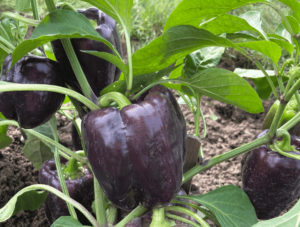
Pepper ;’Dragonfly’
Credit: All-America Selections
‘Dragonfly’ stands out most for the color of its fruits – purple on the outside and lime green on the inside. AAS judges also liked the heavy yield, the fruits’ thick walls, and how the fruits are held high on the plant. Plants grow 24 to 36 inches tall. Full sun.
This new indeterminate, cherry-tomato variety is also distinct for its fruit color and heavy yield, producing up to 200 three- to four-ounce, little, round tomatoes that are dark red with green stripes. ‘Purple Zebra’ also has very good disease resistance. Full sun.
This annual flower stood out for its brilliant yellow color (unusual in petunias) as well as its heavy bloom and its ability to not fade in summer heat. Grows about 10 inches and has a mounding habit.

Petunia Bee’s Knees
Credit: All-America Selections
Begonia Viking Explorer Rose on Green
Viking Explorer Rose on Green is a hefty, versatile, trailing begonia with a very heavy bloom of rosy-pink flowers that’s ideal for a hanging basket or pot. It has glossy green foliage and grows 16 inches tall with a 32-inch spread in full sun or part shade.
Rather than produce one or just a few big flowers at the top of the stem, Concert Bell is an annual sunflower that produces 10 to 12 big flowers per plant that grow all around and down the stem. Plants are five- to six-feet tall, can be direct-seeded into the garden, and grow best in full sun.
Originally a program of the Mailorder Gardening Association, Green Thumb is now run by the National Garden Bureau, a century-old non-profit organization that promotes gardening on behalf of the horticulture industry.
A panel of NGB members picks winners based on four criteria: uniqueness, technological innovation, ability to solve a gardening problem or provide a gardening opportunity, and appeal to gardeners.
Four plants won 2022 Green Thumb Awards.
Sweetshrub Simply Scentsational
This new variety of native shrub won for its fragrant, deep-maroon, late-spring flowers that smell like a blend of pineapple and bubblegum. Simply Scentsational grows about six feet tall and five feet wide in sun or part shade.
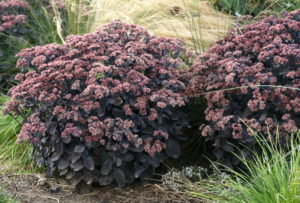
Sedum Back in Black
Credit: Walters Gardens
Sedum ‘Back in Black’
Sedum ‘Back in Black’ is a new perennial with succulent leaves that are nearly black. It produces umbrella-like clusters of cream and garnet in late summer and grows 18 to 24 inches tall, ideally in full sun.
Salvia ‘Hummingbird Falls’
This Green-Thumber is another new introduction – an annual that’s groundbreaking as the first trailing form of this type of salvia. ‘Hummingbird Falls’ is heat-tough and produces summer-long blue flowers with black bases that hummingbirds love.
It’s ideal as a hanging-basket plant in full sun.
Pepper ‘Candy Cane Chocolate Cherry’
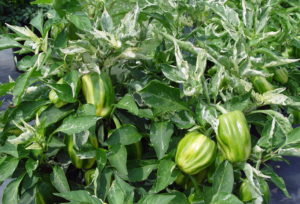
Pepper ‘Candy Cane Chocolate Cherry’
This good-looking new mini-bell pepper stands out for both its striped fruits and variegated leaves. The fruits end up maturing to chocolate-cherry red and are sweet in flavor. Plants grow about two feet tall, ideally in full sun.
Herb Society Notable Native Herb
Every year, the Herb Society of America’s Native Herb Conservation Committee selects one or more native plants that deserve more use in American gardens. The selections are called Notable Native Herbs (although not all are herbs).
For 2022, a woodland perennial and a small tree won Notable Native honors:
Goldenseal (Hydrastis canadensis)
Goldenseal is a colonizing woodland native perennial that’s become endangered in the wild. Although it can take five years to bloom for the first time, it then produces spring white flowers followed by red mid-summer berries.
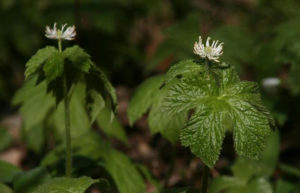
Goldenseal
Credit: Chris Evans, University of Illinois, Bugwoood.org
Plants grow about a foot tall and do best in shade to part-shade sites and damp soil.
Fleshy hawthorn (Crataegus succulenta)
This hard-to-find native small tree features white flowers in May and then red fall berries that cedar waxwing birds love. It’s also a good bee- and pollinator-attractor.
Fleshy hawthorn has thorny branches and grows 15 to 20 feet tall in sun or part shade, often with multiple stems.
The Society of Municipal Arborists, whose members are government tree experts and urban foresters, each year picks a tree deserving greater use because of tolerance to harsh, urban conditions combined with “strong ornamental traits.” The 2022 winner is:
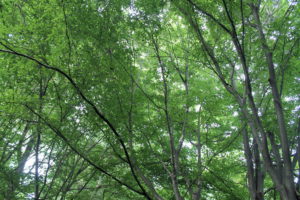
American hornbeam or “musclewood”
Musclewood (American hornbeam) (Carpinus carolinana)
This mid-sized shade tree (20 to 30 feet tall) is native to the eastern United States and gets its name from its sinewy gray bark that looks a bit like flexed muscles. The toothy-edged green leaves turn a blend of red, orange, and yellow in fall. Prefers moist soil and full sun.
American Garden Rose Selections
This program of the rose industry and American Rose Society evaluates roses at 13 different trial gardens in six U.S. geographical regions, looking for superior performance in beauty, fragrance, disease-resistance, ease of care, and more.
Two roses earned AGRS awards in the Northeast region for 2022:
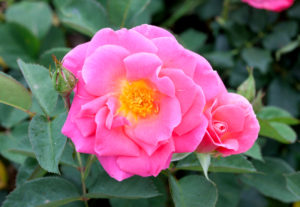
Rose Pink Freedom
Credit: Weeks Roses
Pink Freedom
Pink Freedom is a shrub rose with large, old-fashioned, pink flowers that have yellow throats. This Weeks Roses and Spring Hill Nursery introduction blooms continuously throughout summer and grows about five feet tall and three feet wide. Full sun to light shade.
Pretty Polly Pink
From Chester County’s Star Roses and Plants, this polyantha rose is a very heavy bloomer of double bright-pink flowers that blooms from late spring to frost. It also has very good disease resistance and grows two-and-a-half feet tall and three feet wide. Full sun to light shade.
American Rose Trials for Sustainability
A.R.T.S. is a rose-evaluation program that aims to identify the regionally best roses in eight different U.S. climate regions.
No-spray evaluations at 19 botanic-garden, university, and park trial sites look at bug and disease resistance, drought tolerance, beauty, vigor, and more over two years. Ones that out-perform the comparison industry standards win “Local Artist” awards.
Three roses – all shrub types – scored well enough to earn 2022 Local Artist honors in our region.
Pink Freedom
Not only did Pink Freedom win an above AGRS award, it won awards in five regions of this program, too, earning it an A.R.T.S. Master Rose award.
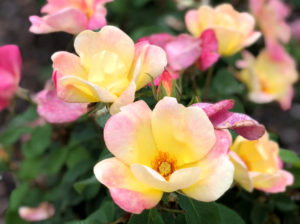
Rose The Champion Sunblush
Credit: Greenleaf Nursery
The Champion Sunblush
This compact, long-blooming shrub rose from Greenleaf Nursery produces bicolor flowers that open yellow and transition to pink as they age. Plants produce a blend of those color stages throughout the summer on plants that grow about four feet tall and wide. Best in full sun.
The Grand Champion Red
Also from Greenleaf is this drought-tough, disease-resistant shrub rose that produces double, round, red blooms from late spring through summer. Grows four feet tall and wide, ideally in full sun.
Members of the American Rhododendron Society each year select top-performing rhododendrons and azaleas in eight different U.S. regions.
Four winners were named for 2022 in the Mid-Atlantic region, which includes much of Pennsylvania. Ideal light is morning sun and afternoon shade.
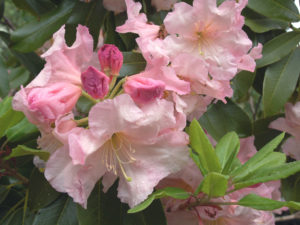
Rhododendron ‘Dexter’s Honeydew’
Credit: Don Hyatt
Large-leaf rhododendron: ‘Dexter’s Honeydew’
The wavy-edged flowers of this mid-spring bloomer are pale purple at the margins, fading to greenish white at the center with a light yellow throat. Grows wider than tall, typically about four feet tall in 10 years.
Small-leaf rhododendron: ‘Oritani’
This very cold-hardy award-winner has moderately glossy leaves, a dense habit, and funnel-shaped pink flowers in April. Grows about four feet tall in 10 years.
Evergreen azalea: ‘Quakeress’
The April flowers of this evergreen azalea are white with hints of purple. Grows about six feet tall in 10 years.
Deciduous azalea: ‘Aromi Sunstruck’
Vivid yellow flowers with orange-yellow blotches are the hallmark of this May bloomer, which drops its leaves in winter. Grows about six feet tall in 10 years.
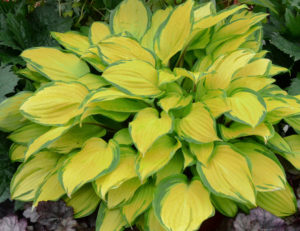
Hosta ‘Island Breeze’
Credit: Walters Gardens
Members of the America Hosta Growers Association each year vote on a favorite hosta variety that must be a superior performer nationwide. This year’s winner:
‘Island Breeze’
This offspring of the popular ‘Fire Island’ hosta has a wider green margin and thicker leaves than its parent. New leaves emerge bright yellow.
‘Island Breeze’ flowers lavender in late summer and has red stems and a mounding habit. Grows 15 inches tall and 30 inches wide, ideally in shade to part shade.







